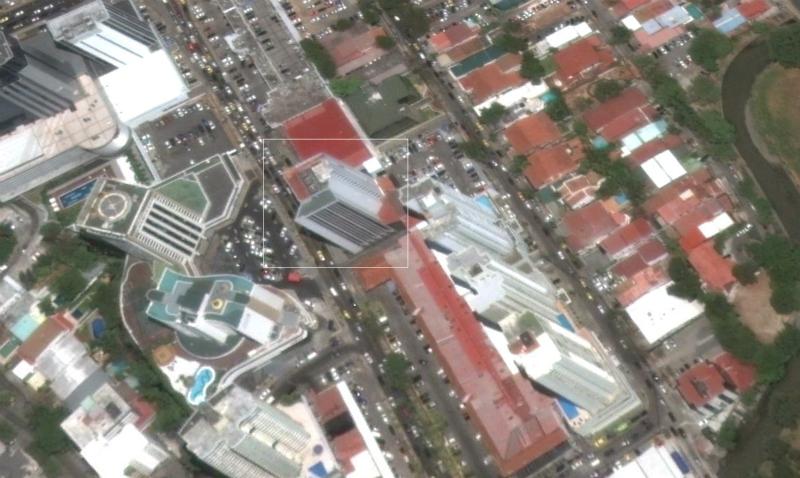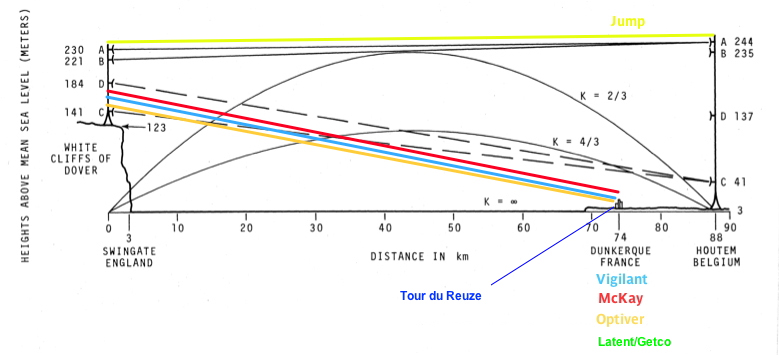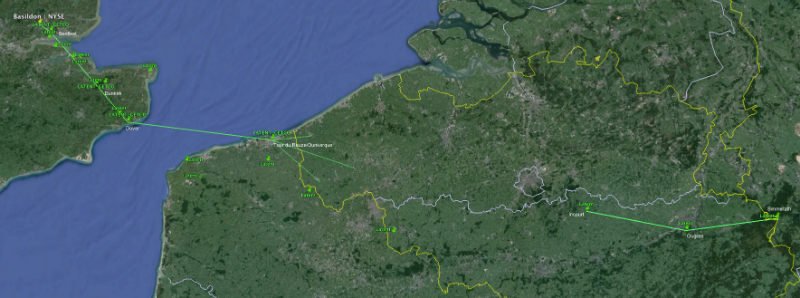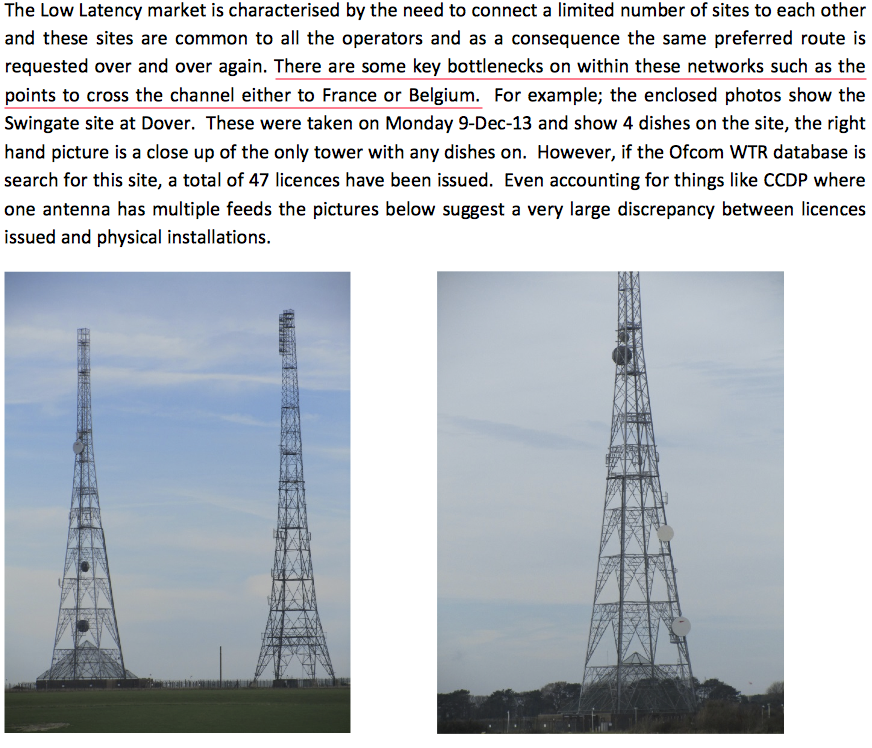High Frequency Trading Neighborhood - Part IV

Note Perev .: This is the penultimate part of a series of translations about high-frequency trading in Europe. In the first part, the author talked about the nature and history of using microwave radiation in trading, in the second part he told how he (almost secretly) penetrated the protected area of one of the Belgian towers, on which HFT traders were transmitting antennas, the third part was devoted to "HFT-piracy" - communication between floating pirate radio stations of the 1960s and modern high-frequency traders. We wanted to make a brief summary of this part, but decided that it was better to give the floor to the author himself.
[ first part ] [ second part ] [ third part ]
')
In the course of my research (which was rather a fascinating hobby than a full-fledged work), I didn’t even have to face stories that could be used to write a script for a HBO or Netflix series. The small world of HFT communication lines is full of surprises. One of them is the only organization that I haven’t talked about so far: Latent Networks. Thanks to Latent, I learned a lot about how nature (i.e. microwave radiation) becomes a commodity from competing HFT firms.
From Malta to Cyprus and Panama
I began my acquaintance with Latent Networks when I discovered Cartoradio , the website of the French national frequency regulator . With the help of Cartoradio, I started mapping towers located in the north of France. There was nothing special about the Latent - they received their first license in France on February 5, 2013. Since I have not heard anything about this organization, I downloaded the official list of detailed contacts of all active radio companies in France. All HFT competitors are open, in the sense that they have a postal address and offices with people working in them. The first curious fact about the Latent: it turned out that the company is registered in the Republic of Malta, and I thought that it was quite unusual for a HFT organization to be located in a tax haven. I asked a few experts from the industry about Latent, and the answers were evasive (however, later I realized that some people know more than they told me first, I think they wanted to read my first posts before providing more data).
At that time (it was about the middle of July) I found this company in the Official Registration Office of Malta Companies, but the only thing I dug out is the name of the company and its ID; if I had spent a lot of money, I could have gotten a “registration certificate” where I thought to find the names of the owners of the company ... but instead of them I unexpectedly jumped from Malta to Cyprus and Panama. In short: Latent Networks Limited was registered on September 4, 2012 in Malta and located in Sliema. The manager of the firm’s business was a man with a Polish name Kříštof Kubala, working for a company called Taxways Group . The address of the Taxways Group in Malta is the same as the Latent address, but the main office of Taxways is located in Warsaw . Another company named Alter Domus (a nice name for a tax haven company) is mentioned in the Latent registration certificate.
Latent Networks Limited has two influential shareholders: the first is the Invest Group Limited company, located in Sliema, Malta, as well as the Latent and Taxways; the second (and main) shareholder is Batlaw Holdings Limited, a company incorporated in ... Cyprus. If you search the publicly accessible website of the Cyprus Company Registration Department, you will quickly find that one of the directors of Batlaw is Křishtof Kubala, the man who stands behind Taxways in Malta and it turns out to be the CEO of the Invest Group; Moreover, the Batlaw Cyprus business manager is another Pole related to Taxways, Invest Group and Latent in Malta. Confused? Now there will be another tricky move: on November 23, 2013, a few weeks after the registration of the Latent, Batlaw shares were transferred from Cyprus to a company called Amicalle Corp., located in ... Panama. And this is a completely different network. SuperMontage network [SuperMontage is an integrated trading system used on the NASDAQ].
If you register in the Panama Public Registry, you will find out that the shareholders of Amicalle Corp. are two other companies, Dubro Limited SA and Aliator SA [isp. SA - Sociedad Anonima, the same as LLC], each of which has two identical shareholders: Cheswick Inc. and Eastshore Inc. If you try to find out who heads Cheswick and Eastshore, you will find many directors, managers, etc., who are also directors, managers, etc. hundreds or thousands of other companies. Ladies and gentlemen, welcome to Panama! All these firms are located on 54th East Street - this is a new tower for the world of the HFT type:

Latent Network
The creators of Latent Networks, without a doubt, simply adore tax havens. Panama is their destination. I suspect that countless companies from this tower are managed by Mossack Fonseca & Co , a large law firm that is “one of seven, representing more than half of the companies registered in Panama,” according to Wikipedia . Back to Malta: I realized that there are several other companies associated with the Latent at the same address in Sliema: NGN Europe Limited , registered a week after the Latent in September 2012 and owned by the Latent; and two other firms named Latency Engineering Blue Limited and Latency Engineering Green Limited . I am not at all paranoid, but, taking into account the Malta-Cyprus-Panama-Warsaw network, the question might have arisen: why does a high-frequency network of radio-relay communication lines need a SuperMontage system worldwide? I thought that only drug cartels, the mafia or banks used such an intricate structure. The story of the Latent's SuperMontage system would ideally form the basis of the John Le Carré novel.

And again, Chicago in Belgium
I didn’t think much about Latent when I tried to make my own map of communication lines (I just thought that the SuperMontage system in tax havens was rather unusual), but in the end I found something purely by chance. At some point, I decided to check all French licenses that give permission to cross the border (France-England and France-Belgium), because I wanted to make sure that I did not lose sight of any unknown organization. So I found a document that could not be found if I searched for the name “Latent” on the ARCEP website . The document is here . This is the latest license issued to Latent Networks on February 29, 2014, but the application was not submitted by Latent; The name of the applicant company is Global Colocation Services LLC. In other words, this is a fairly well-known Chicago firm called ... Getco.

Global Colocation Services (GCS) is a subsidiary of Getco. Getco is now known as KCG since the company merged with Knight Capital last year (Knight collapsed on August 1, 2012 due to a minor problem with one of its smart order redirection systems). Getco was one of the first high-frequency trading companies in Chicago; founded by Daniel Tierney, a former trader in the Chicago Board of Trade, and ex-broker of the Chicago Mercantile Exchange Steven Schuler. I was glad to find Getco in Europe, because together with the founders of Jump Trading, Tirney and Schuler were also on the famous platform towering above the pits of the Chicago Mercantile Exchange, which was discussed in Part I.
But how are Latent and Getco related? I did not think that the Latent - and there is Getco. I could not imagine that KCG needed tax havens (everything that US citizens need is in Delaware, isn't it?). I googled the name Global Colocation Services in France and Belgium and found that GCS was registered in Belgium (Brussels) on October 25, 2013 and in France (Paris) on November 25, 2013. No doubt, these two companies were created to manage Latent licenses. Here is the proof: I found the name "Global Colocation" in the telephone directory of France. The Global Colocation address points to a tower in Dunkirk, known as the Tour de Rouz, where many HFT competitors ("Vigilant, Optiver, McKay, Latent) are installed:


It looks like the Tour de Rouz, which was originally conceived as a fashionable hotel, and eventually became an ordinary apartment building
Let's return to Latent Networks. The fact that Getco / Global Colocation Services uses the Latent frequency range is confirmed if you visit the official website of the UK state radio regulatory authority. The Ofcom website has this map that allows you to find radio operator licenses. But there is another place called " Spectrum Trading ". Before high-frequency traders can use microwave links to trade anything they want, network service providers must order and purchase licenses to use the frequency range. In the UK, a license is issued for a route between two points / towers. This license can be sold in such a way that, when the radio operator does not need it anymore, Spectrum Trading will provide an opportunity to resell their licenses to those who are ready to purchase them. Being a natural resource, microwaves are sold - after all, this is the market.
A few days later, I discovered a French license in the name of “Latent Networks” and “Global Colocation Services”; I guessed that Latent sold two British Getco licenses on March 31, 2014. These two licenses of Latent Networks were acquired to cross the channel from the Tour de Rouz in Dunkirk to Dover in the UK (which is consistent with the French license). Two weeks ago, Ofcom’s site was disconnected due to a server update, but when it started working again ... what a surprise I was when I saw that on September 23, 2014, Latent had sold its Getco licenses:

I believe this was the reason for registering Global Colocation Services LLC in the UK. If you compare the Latent license numbers with the licenses sold by Getco, you will quickly guess that the Latent sold Getco all the way from the Tour de Rouz to the NYSE data center in Basildon (this time I am sure that the routes recorded on my map are accurate to 100 %;). Shown here is the Latent-Getco network from Germany to Basildon. I know that some of the towers in Belgium are not listed, but there is no publicly available data in my country, so I don’t know where the Latent could set up its “plates” between the Tour de Rouz in Dunkirk and Encourt in Belgium (I didn’t designate points corresponding to several old Towers that the Latent no longer uses):

Dark affairs near the channel
Once again, this does not mean that Getco stands for the Latent, the Latent only sold the British licenses to Getco, period. But I thought it was rather strange, since in the world of HFT communication lines there are two kinds of competitors: trading firms, such as Optiver from Flow Traders, which created their own network for themselves, and suppliers, like McKay Brothers and Custom Connect. They sell frequency bands to customers (trading companies, hedge funds, banks, etc.), but they do not resell frequency bands, routes, or licenses to trading companies. Therefore, the case of Latent is rather unusual: the organization is not a supplier selling frequency bands, nor is it a trading company. I did not find any general data indicating that Latent was selling British licenses to other companies besides Getco. Anyway, the fact that the first Getco licenses acquired from the Latent in March 2014 were required to cross the channel should be noted. Even more than I expected.
In the course of my research, I came across a curious publicly available document found on Ofcom's website. Below is a statement made on December 13, 2013 at a meeting of Ofcom partners (here partners are operators, whom Ofcom gave the right to speak on issues of interest to them). The statement was made by Jan Marshall on behalf of Aviat Networks. I do not know Mr. Marshall, but as a regulatory manager at Aviat, he wrote several articles on his blog on wireless technology. Particularly noteworthy is the article entitled “Rules of the game: microwave radiation with low latency in multi-regulation conditions”. Remember that Aviat Networks is a supplier of equipment for various radio operators, including HFT competitors. “When Aviat Networks helped McKay Brothers LLC conduct a network with a small delay between Chicago and New York,” Marshal wrote, “there were some technical difficulties in diagnosing that needed to be dealt with. [...] With all the complexity of this circumstance, his decision turned out to be simple compared to the level of complexity of legislation that we felt when we arrived in Europe to conduct a network with low delays connecting the leading financial hubs - London and Frankfurt. [...] When crossing the border, regulatory obstacles will always arise when a similar transnational network is established. The situation is exacerbated if the border is also a geographical barrier, such as the ocean. ”
Two months after writing the article, Marshall used the same words at the Ofcom partner meeting in December 2013. Here is the first part of his statement: “Aviat Networks understands that Ofcom is not currently going to impose restrictions on network expansion, since the license was issued for a two-point communication line. However, we learned that organizations that use low-latency networks (HFT companies) were issued a huge (over 200) number of licenses, and therefore we have reason to believe that this should lead to the construction of appropriate infrastructure. We are firmly convinced that a huge number of speculations are taking place in this area, and this, in the final analysis, leads to the “blocking” of key routes throughout the UK. ” Below is the next part with images of the towers in Swingate, near Dover, on which most HFT competitors (Optiver, Vigilant, Jump, McKay Brothers) have installed or will install their antennas to cross the channel (the red underline is mine):

All this is very interesting. In short, Mr. Marshall reported to the UK state radio regulatory authority that some HFT competitors demanded licenses without installing antennas, just to “occupy” the frequency range and interfere with the rest. In other words: you require a larger frequency range, so that your competitors can no longer receive them; in this case, they will not be able to cross the channel, and since they cannot cross the channel, they will not be able to create a network between Frankfurt and London. It's simple: trading companies need microwave radiation; without microwave radiation, companies will not be the fastest. That is why the "huge number of speculations" is carried out near the channel. The statement by Mr. Marshall confirms the “rumors” about the “occupation of the frequency range and the occupation of the towers” mentioned by Bloomberg . But here, not far from the North Sea, the rumors turned out to be facts. I know for sure (at least) two competitors who have experienced serious difficulties in obtaining the range of frequencies necessary for crossing the channel, because of the occupation of frequencies or speculation. The first was a microwave supplier; the second was a prop trading company. Therefore, it became interesting to me: who occupied the frequency bands? Who tried to speculate on microwave radiation? A few days later, the answer came to my email. It was just incredible.
On August 3, at 23.13, at that moment when I quietly got ready to go to bed, I received a letter with the heading "Latent and others." The email was sent via paranoici.org , used by an anonymous sender "to hide his identity by sending emails". Strange isn't it? I read the first lines of the letter. “What the hell,” I told myself, opening my eyes. But let's start with the last three lines: "Want to know more, give a signal / Happy hunting / Kangaroo badge." The only way to find out what I'm working on right now was Twitter. I posted one or two tweets about my research, and I was sure that none of my informants would send an anonymous letter to me. That inscription with the "kangaroo" was strange. The caption read: "Kangaroo badge." I began to suspect that my anonymous informant was an employee of Jump Trading. Why? But because what does the kangaroo do? He jumps [eng. jump]! So I posted an encrypted tweet for kangaroo, but that was stupid. Very stupid. Kangaroo was not at all an employee of Jump Trading. One HFT competitor read my tweet and wrote to me that I was wrong, adding that one person from Latent Networks wears a kangaroo badge on a jacket. Wow. The Kangaroo badge was not a signature, but a hint. Kangaroo was a Latent man I was looking for. Awesome
But the most striking in the letter was the first paragraph. Take a deep breath:
“Pay attention to [Kangaroo]. [Kangaroo] worked at [Company]. [Company] sells a lot of microwave devices to all types of organizations from the high-frequency trading vertical. [Kangaroo] has access to many, if not ALL of the routes of each HFT company. [Kangaroo], working at [Company], himself founded the company, calling it Latent Networks Limited. [Kangaroo] stole the routes of all the companies, and then registered all the frequency bands to occupy. His main and perhaps only client is Getco. There is a rumor that Getco has acquired several licenses to cross the channel from Latent Networks Limited. ”
Oh oh oh. Let's pause. My initial goal was to map radio-relay communication lines in Europe. Studying these lines of communication, I just wanted to understand how high-frequency traders confront nature. , . , , , , , , . , , , ( ), , , . .
: Getco – Latent, «» – , Ofcom. : Latent , , (), , – , . « HFT-» . , «», , ( ), , «» HFT-. , . ? : , - , .
«, Latent , ». , , «», . , , , «» «» Latent Networks. , «» «» ( ), -, . .
-, , , « , , ». - . , , , , , - , . , , , , , , Getco Latent. , , , HFT- , , : Getco , Latent?
«»
«» , Latent Networks. , «» , , , , , (, , ), , , , . , .
- , «» , ! ( Ofcom – , «», , ). - , - «». «… … », – . :
2013 , , Trade Tech Europe 2013 . , (.). «» , Trade Tech , ( 3 000 ).
, , AFM ( , Panopticon), . , , . , . , , , HFT-. , «».
To be continued...
Source: https://habr.com/ru/post/245675/
All Articles